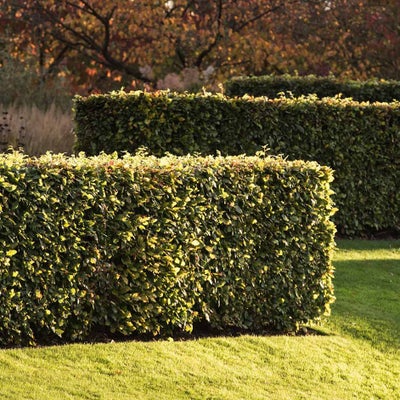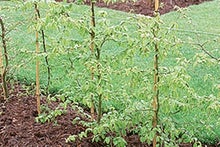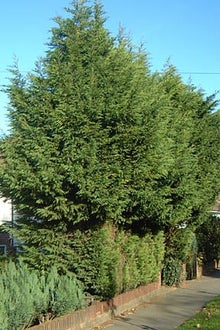
Quick facts
5 hedging plants with multiple environmental benefits:
Beech - (Fagus sylvatica)
Holly - (Ilex aquifolium)
Roses - (Rosa)
Privet - (Ligustrum species and cultivars)
Western red cedar - (Thuja plicata)
Introduction
RHS Science research has shown that some hedging plants are known to be good at providing particular benefits, and here we explain what plants to grow and how best to get the benefits on offer.
Hedges create living boundaries to our gardens, providing foliage texture and architectural interest all year round. Add to this that they are homes to wildlife and provide numerous environmental benefits (ecosystem services), and it’s certainly worth considering them when replacing fences and walls, even if there is need for annual maintenance.
The information provided here is based on a published RHS review of the available scientific evidence. For the first time, it assesses all the ecosystem services provided by the plants used to make hedges. As a result, it is now possible to say which services different hedging plants are currently known to provide (it’s very possible they do more, it’s just they haven’t been subjected to scientific scrutiny).
What are the benefits?
Air pollution capture
Poor air quality can have significant negative impact on respiratory and cardiovascular human health. The capacity of plants to generally remove air pollution is well documented, but figures about the effectiveness of their removal shows it’s hard to currently fully understand how well they work. However, hedges – as barriers between sources of pollution like traffic and urban residents – have a positive effect, at least in improving air quality in the local area around the plants.
Flood mitigation
Managing rainfall is an increasing issue for towns and cities due to the continuing reduction in the area of permeable surfaces – and the predictions for more heavy rainfall events due to climate change. A 2016 survey by the RHS suggested one in four UK front gardens are paved over and nearly one in three front gardens have no plants. Through carefully planting, however, gardens can offer more protection against flooding in the UK.
Noise reduction
Vegetation shelter belts, including hedgerows, have a potential to reduce noise by up to 8 dB. This is in the context where prolonged noise levels of more than 40 dB at night time, and 65 dB in the daytime, are considered harmful for human health.
Support for wildlife
Hedges in urban environments are crucial in supporting a wide diversity of animal species through the provision of shelter, nest sites, food resources and corridors for movement.
Other benefits
Hedges provide numerous other (but scientifically less studied) environmental and practical benefits. These include sheltering, cooling and temperature regulation as well as carbon sequestration and phytoremediation of soil pollutants. Additionally, they can reduce stress levels in humans through visually stimulating us.
Video on how to plant a hedge and why it’s better than a fence
How do I get the benefits from hedges?
Firstly, choose which benefit is most important to you. If you live on a busy road, that might be pollution. If you love wildlife, then one that supports it would be appropriate. The next step is to see the corresponding section below for the best plants and design tips.
It’s important to realise that all the plants listed will provide other benefits – it is rare for a plant to be good at providing just one benefit; they usually provide multiple benefits. As a result, if you're just after plants that can provide good levels of most benefits, consider planting:
- Beech (Fagus sylvatica)
- Holly (Ilex aquifolium)
- Red Japanese rose (Rosa rugosa)
- Privet (Ligustrumspecies and cultivars)
- Western red cedar (Thuja plicata)
Please note
For plant informaton and suppliers, click on the link for each plant for details.
Hedges for specific benefits
Air pollution capture
How do plants clean the air? Plants with small ovate, rough, hairy or scaly leaves trap small dust-like particles – the so-called airborne particulate pollution. This is either washed to the ground by rain or falls off with old leaves.
How do I get the maximum benefits? Grow large and dense hedges to get the maximum surface area on which to trap the pollution – aim for at least 1.5m (5ft) high and 1m (3⅓ft) deep. Choose from the plant list below. In theory, one plant grown to the dimensions mentioned can capture 60 diesel cars' worth of pollution each year. This will vary in real life, but demonstrates the pollution-capturing potential of plants and hedges.
- Cotoneasters
- Elaeagnus × submacrophylla (syn. Elaeagnus × ebbingei)
- Common yew (Taxus baccata)
- Western red cedar (Thuja plicata)
Carbon sequestration
How do plants store carbon? Carbon dioxide from the air is taken in through pores in the plant and some is converted to make the woody structure. Faster-growing plants can store more carbon in less time. While large, mature hedges will store the most carbon, the overall amount stored will increase little once they are maintained at their desired size.
How do I get the maximum benefits? Choose from the plants below and allow the hedge to mature. You can improve the carbon storing by the clippings and using the in your garden – the soil is also a great place to store carbon.
- Beech (Fagus sylvatica)
- Bay (Laurus nobilis)
- Laurustinus (Viburnum tinus)
- Western red cedar (Thuja plicata)
Cooling and thermal insulation
How do plants cool the air? Hedges provide cooling by shading the area around them and by transpiring cooling water vapour. They also insulate by filtering/blocking the wind, reducing the ‘wind chill’ on the buildings next to them.
How do I get the maximum benefits? Choose from the plant list below.Grow larger hedges as they will have a larger surface area so can shade and transpire more than small ones. However, hedges of any size will provide a proportional amount of these benefits.
Plant on the sunny side of your garden so the hedge casts more shadow in summer. If you live in a cold area, choosing a plant as this will allow some sunlight (and warmth) through in winter.
- Cherry laurel (Prunus laurocerasus)
- Cotoneaster franchetii
- Forsythia × intermedia
- Lonicera ligustrina var. yunnanensis(syn.Lonicera nitida) and cultivars
Flood mitigation
How do plants reduce flooding? Plants with large leaf surfaces, higher rates of (i.e. losing more water vapour from leaves and stems) and evergreen canopies have been associated with greater rainfall retention, slowing the water reaching the ground and with reduced water runoff (by increasing the soil's capacity to store water).
How do I get the maximum benefits? Grow a larger hedge as this will have a larger surface area, making it more effective. Choose from the plants list below; especially the evergreens.
- Cotoneasters – there are deciduous and evergreens to choose from
- Forsythia × intermedia– works best when in leaf, so good where heavy summer rains are an issue
- Hawthorn (Crataegus monogyna) – works best when in leaf so good where heavy summer rains are an issue
- Privet (Ligustrumspecies) – semi evergreen; it tends to be fully evergreen in mild areas and towns and cities.
Noise reduction
Solid continuous barriers (in the form of walls and fences for example) are best at intercepting and reducing noise. Plants and soils have a small role to play and can act to reduce noise in the higher frequencies (e.g. high pitched voices, sirens, dog’s barking). Plants’ role is small or negligible in mitigating lower frequencies (e.g. traffic noise).
How do plants reduce noise? Plant structures can act as a partial noise barrier (by absorbing or scattering the sound, therefore helping the sound wave lose some of its energy). Soil too has a role in absorbing a proportion of soundwaves.
How do I get the maximum benefits? Choose from the plants list below. Aim to grow a hedge that is wide and tall (ideally at least 2m/6⅔ft). Evergreens of dense canopies are best. Clipping a hedge will make the surface denser over 5-15 years, which will increase the effectiveness of noise barrier.
If noise reduction is a priority in your garden, consider combining hedges with a barrier (a panel fence, brick wall or similar). This is because for low frequency noise (such as traffic), a continuous solid barrier has the greatest impact.
- Cherry laurel (Prunus laurocerasus) – evergreen
- Common yew (Taxus baccata) – evergreen
- Holly (Ilex aquifolium) – evergreen
- Japanese barberry (Berberis thunbergii) – deciduous
- Western red cedar (Thuja plicata) – evergreen
Support for wildlife
How do plants benefit wildlife? Most provide shelter for birds, and some hedges (such as common yew, hawthorn and pyracantha) also provide food such as berries and flowers to provide pollen and nectar for insects.
How do I get the maximum benefits? Plant a mixed hedge to extend flowering and fruiting times. This could be a mixture of the plants below or a mixed hedge (a type offered by suppliers containing plants including beech, hawthorn and roses). Supporting wildlife isn't just about planting a hedge, so don't forget to include other insect and bird friendly plants in your garden.
- Beech (Fagus sylvatica)
- Common yew (Taxus baccata)
- Hawthorn (Crataegus monogyna)
- Red Japanese rose (Rosa rugosa)
- Privet (Ligustrumspecies)
- Pyracantha(firethorn) cultivars
How much difference can plants make?
Hedges can bring benefits to an individual garden, but at a bigger scale such as a whole street, the total amount of greenery compared to built surfaces is more important.
For example, in a small garden, if cooling is required, growing large, dense hedges that take up and release more water will reduce the temperature most effectively. Therefore plant choice is especially important in a small garden.
However, at the scale of the whole street, temperature is affected by many factors, such as building height and design, weather and air circulation. In this bigger picture, how much greenery there is compared to hard or built surfaces (balance of green versus grey) is more important than the choice of individual plants. Having more green surfaces will have the greatest benefit.
One exception, to a point, is the support for wildlife - gardens are known to act as corridors and stepping stones for wildlife irrespective of individual garden size, so the choice of planting remains significant.
Where and how to plant hedges
Hedges can be planted in most locations. Just take into consideration the plant details mentioned above such as whether they are evergreen or , their height and spread, and remember that most hedges will need an open, sunny site to thrive. There are a few exceptions, such as yew and holly, which cope with shade.
Traditionally hedges are grown along garden boundaries, but they can be used to divide a garden into smaller spaces or used to create shapes and features in their own right – the winter garden at RHS Garden Harlow Carr in Yorkshire showcases this idea with sculptural forms of common yew. This gives the opportunity to get the benefits of hedges in unconventional locations.
There is some evidence that hedges generally may have a role to play in designing health restorative landscapes. The use of hedges has helped create garden rooms – a feature are associated with ‘refuge sites’ for humans. Hedges provide a degree of seclusion as well as reduce/give the perception of less noise that can be appreciated by certain individuals.
How to plant hedges
Evergreen and semi-evergreen hedges are best planted in late-October and early November, and March. Deciduous hedges can be planted from late October until March, as long as the ground is not or frozen at the time of planting.
How much maintenance do hedges need?
Left unclipped, most hedges contain plants that naturally want to be trees. To prevent this happening, and to create a dense face and top, trimming is usually required once or twice a year. In the list below you can see which need more or fewer regular cuts each year.
Hedges that are trimmed at least annually can provide environmental benefits for many decades. It’s common to see a hedge outlast three or four neighbouring fences during their lifetime, which makes them a very cost effective option over the years too.
- Bay (Laurus nobilis): Evergreen. Hedge heights of 1.2-2m (4-6⅔ft). Typical number of cuts per year: one.
- Beech (Fagus sylvatica): . Hedge heights of 1.2-6m (4-20ft). Typical number of cuts per year: one.
- Common yew (Taxus baccata): Evergreen. Hedge heights of 1.2-6m (4-20ft). Typical number of cuts per year: one.
- Cotoneaster franchetii(cotoneaster): Semi-evergreen. Hedge heights of 1.5-2.4m (5-8ft). Typical number of cuts per year: two.
- Cherry laurel (Prunus laurocerasus): Evergreen. Hedge heights of 2-4m (6⅔-13ft). Typical number of cuts per year: one to two.
- Elaeagnus × submacrophylla* (syn. Elaeagnus × ebbingei): Evergreen. Hedge heights of 2-3m (6⅔-10ft). Typical number of cuts per year: two.
- Forsythia × intermedia: Deciduous. Hedge heights of 1.2-2m (4-6⅔ft). Typical number of cuts per year: one, after flowering.
- Hawthorn (Crataegus monogyna): Deciduous. Hedge heights of 1.5-3m (5-10ft). Typical number of cuts per year: two.
- Holly (Ilex aquifolium): Evergreen. Hedge heights of 2-4m (6⅔-10ft). Typical number of cuts per year: one.
- Japanese barberry (Berberis thunbergii): Deciduous. Hedge heights of 60cm-1.2m (2-4ft). Typical number of cuts per year: one to two.
- Laurustinus (Viburnum tinus): Evergreen. Hedge heights of 1.2-2m (4-6⅔ft). Typical number of cuts per year: one, after flowering.
- Lonicera ligustrina var. yunnanensis(syn.Lonicera nitida) and cultivars: Evergreen. Hedge heights of 60cm-1.5m (2-5ft). Typical number of cuts per year: two.
- Privet (Ligustrumspecies): Semi-evergreen. Hedge heights of 1.5-3m (5-10ft). Typical number of cuts per year: two.
- Pyracantha (firethorn): Evergreen. Hedge heights of 2-3m (6⅔-10ft). Typical number of cuts per year: two to three.
- Red Japanese rose (Rosa rugosa): Deciduous. Hedge heights of 1.2-1.5m (4-5ft). Typical number of cuts per year: one.
- Western red cedar (Thuja plicata): Evergreen. Hedge heights of 1.5-3m (5-10ft). Typical number of cuts per year: one to two.
Don’t hedges become too tall?
If hedges aren't trimmed regularly, they will grow and try to revert to their natural habit – usually to become tall trees. This only happens when they are not maintained.
Larger hedges are often able to provide more environmental benefits: bigger does equal better in this case. However, the RHS advocates growing a hedge of an appropriate hedge for the location. It should also be noted that two or more evergreens in a line over over 2m (approx 6⅔ft) consititutes a high hedge by UK law. You can grow a hedge over this height but, if it impacts on your neighbours' ‘reasonable’ enjoyment of their house or garden, it's best done with their mutual approval else they could make a formal complaint.
How do we know this?
For this Royal Horticultural Society (RHS) Science review, we selected plant species commonly used in the hedges grown in towns and cities (urban areas) in north-west Europe, by reviewing nursery catalogues (hedging specialists only), consulting nursery business (for the most popular plants sold) and using data from the RHS Gardening Advice service.
The selected species included the ‘top 25’ of the most enquired about hedges received via RHS Gardening Advice service (which receives over 110,000 enquiries annually from RHS Members and RHS Flower Show visitors). Additionally, we included 18 other species that are anecdotally widely used in urban areas in European temperate climates. Many of these species are also used in temperate North America, Asia and Australasia, although the list excluded other species that tend to be used exclusively in these regions.
The focus of our investigation were species that can help ameliorate urban specific issues, so species commonly used in rural locations (within hedgerows or as wind-breaks), but rarely used in urban areas were excluded, e.g. Populus spp.
The above information for gardeners is provided as interpretation of the full science paper, which is freely available to read.
Urban hedges: A review of plant species and cultivars for ecosystem service delivery in north-west Europe(Urban Forestry & Urban Greening, Volume 44, August 2019.)
by Tijana Blanuša (RHS Principal Scientist), Michael Garratt, Margaret Cathcart-James, Leigh Hunt (RHS Principal Horticulturist) and Ross W.F.Cameron
The below paper contains more information about the significance of scale in choosing hedges.
Environmental horticulture for domestic and community gardens—An integrated and applied research approach (Plants People Planet, October 2023) by Mark B. Gush, Tijana Blanuša, Lauriane S. Chalmin-Pui, Alistair Griffiths, Elisabeth K. Larsen, Raghavendra Prasad, Marc Redmile-Gordon, Chloe Sutcliffe
Gaps in our knowledge
The review highlighted that more scientific research is required in some areas. We need to understand more about flood mitigation and health and wellbeing impacts of individual plant species/cultivars, as well as the contribution of mixed hedging.
Anything else I should know?
The plants we studied were overwhelmingly shown to provide positive benefits. However, the research recognised that there are some negatives (disservices):
- Allergenic pollen of a small number of species contributing to hay fever (e.g. Carpinus and Fagus). This however could be mitigated by pruning, to retain hedges in their juvenile form and/or to remove floral structures
- Potentially invasive as some species in certain soil types may be (although in an urban context that is predominantly paved, the risks are generally low)
- Biogenic volatile compounds (BVOCs) as dome species emitting higher concentrations of these
For this study, we didn't find evidence that led us to conclude that any plant from the studied list should not be grown in gardens.


